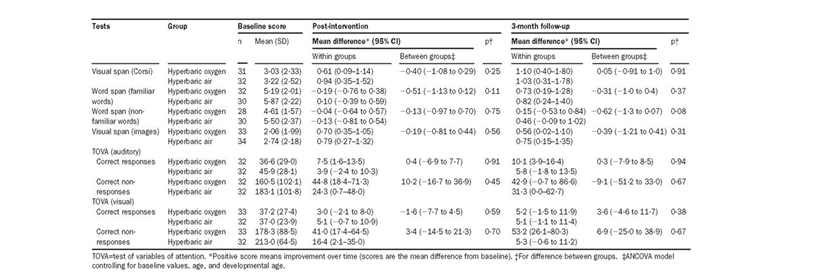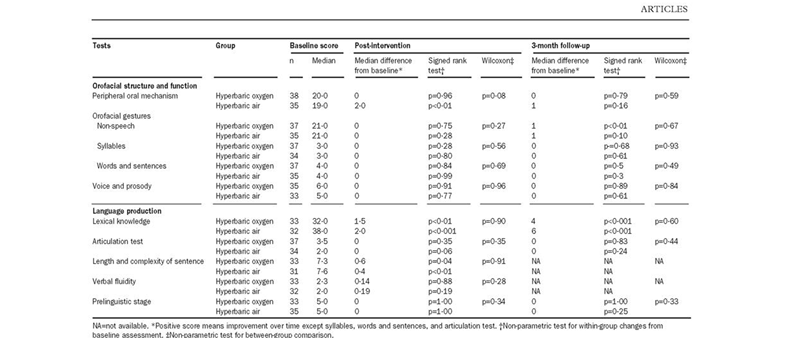Introduction
Cerebral palsy manifests itself in the form of multiple syndromes mainly related to posture and mobility disorders. Brain injury is the major cause of this medical condition. Cerebral palsy is prevalent among young children, with about 50 percent of such children having been born premature (Montgomery et al., 1999). Treatments, including pharmacology and surgery, focus on increasing motor functions by lowering the chances of experiencing spasticity.
However, these medications may have unintended outcomes for children. For instance, those with spasticity are required to undergo various surgical processes that, in turn, may result in further complications. As this paper reveals, hyperbaric oxygen (HBO) therapy is used as an alternative to these procedures. Nevertheless, it has effects that have led to wide scholarly discussions regarding its efficacy in the treatment of cerebral palsy patients.
Effects of Hyperbaric Oxygen Therapy
HBO therapy involves making patients inhale pure oxygen into the hyperbaric chamber at a pressure above one atmosphere. However, such oxygen intake is only allowable up to three atmospheres. According to McDonagh et al. (2003), this procedure has the potential of making patients develop physiological and mechanical effects due to hyperoxia that is usually accompanied by high blood pressure. HBOT is administered in sessions ranging between 90 and 120 minutes. However, there lacks a standard measure regarding the necessary number of sessions to cause the desired results, the frequency, and the appropriate duration.
Collet et al. (2001) studied 111 children with cerebral palsy whereby one group (n=57) underwent HBO therapy using oxygen at 1.3 atmospheres while the other category (n=54) was subjected to a pressure of 1.75 atmospheres. Improvements were noted regarding children’s speech, activity levels, and memory. In terms of the measured outcomes, no differences were observed for the two treatment approaches due to the lack of a normalized method of establishing the appropriate pressure to produce the desired results. However, even with scholarly arguments concerning the standardization and efficacy of HBO, it produces diverse effects on children with cerebral palsy.
For instance, patients experience ear barotraumas, which is the discomfort felt in their ears due to variations or changes in pressure. The study by Collet et al. (2001) reported improvements among young children suffering from cerebral palsy, irrespective of the pressure of the oxygen they were breathing. This situation lasted for more than 3 months (Correspondence, 2001). These findings were remarkable upon considering that medicinal treatments had been stopped for six weeks while physiotherapy had been halted during medication and assessment periods. However, among children undergoing HBO procedures, the risk of ear barotrauma was high.
Particularly, twenty-seven of them suffered from ear barotrauma (Collet et al., 2001). However, one cannot conclusively relate improvements to increments in pressure, oxygen, or parents’ commitment to the treatment due to the non-inclusion of a controlled group. According to McDonagh et al. (2003), there exists inadequate evidence that supports the capacity of HBO therapy to improve different functional outcomes in children suffering from cerebral palsy when compared to compressed room air.
According to research by McDonagh, Morgan, Carson, and Russman (2007) consisting of one hundred children, 12 of them withdrew from this study because they experienced seizures while under HBO treatment. These authors also quote another scholar, Chavdarov, who deliberately ignored children having a history of seizures in the HBO treatment process. Nevertheless, 8 percent of research subjects left this process due to convulsion. In yet another research by Machado, McDonagh, et al. (2007), only seizures were reported as an effect of HBO.
However, recent studies suggest that seizures associated with HBO treatment for children with cerebral palsy do not result in adverse effects. For example, Hadanny et al. (2016) conducted a retrospective analysis of over 60,000 HBO treatment sessions intending to establish different reported instances of seizures. This research included 2,334 patients drawn from Israel and treated from 2010 to 2014. For all sessions, seizures were reported in the ratio of 1:8,945, occurring only among seven patients. Specifically, only one patient suffered from seizures related to oxygen-toxicity. This scholarly work suggests that HBO is a safe and secure treatment option for children and patients with cerebral palsy.
HBO therapy does not always result in negative effects among cerebral palsy patients. Neubauer, Uszler, and James (1998) present various case studies of children who reported positive outcomes upon treatment for cerebral palsy using the HBO therapeutic approach. Similarly, the work of Collet et al. (2001) reveals that this medication method leads to patients’ improved physical ability to conduct daily activities. For example, a 3-year-old boy showed significant improvements when subjected to HBO.
This child suffered from “perinatal hypoxic-ischemic encephalopathy with renal failure consisting of acute tubular necrosis, thrombocytopenia, sepsis, respiratory insufficiency, hypovolemia, and apnea related to seizure disorder” (Neubauer et al., 1998, p.476). For the first time in his life, he held a mug, became more vigilant, began pronouncing new vocabularies, and developed environmental responsiveness. The second case involved a 4-year-old boy who experienced a traumatic problem during his birth. Consequently, he had suffered cerebral rapture in his left part of the brain. He speedily improved after being introduced to HBO therapy within 92 sessions. For example, he could grab things using his right hand, devotedly follow given commands, and even run.
Collet et al. (2001) conducted a neuropsychological appraisal of 75 children who took part in an HBO therapy. This study argues that although improvements were noted regarding their working memory as time progressed, as shown in Figure 1, these researchers did not observe any significant disparities between different groups. Indeed, an investigation done regarding the attention of children under treatment revealed outcomes similar to those recorded during their memory assessment process (Collet et al., 2001).
However, as indicated in Figure 2, after analyzing orofacial structural changes coupled with functioning, these scholars observed no disparities in baseline outcomes except in the case of children subjected to higher pressures during the HBO therapeutic procedure. Although these children demonstrated improvements regarding their capacity to communicate and comprehend language, Collet et al. (2001) did not record any considerable across-groups variations.


HBO as a medication process increases the level of vomiting among children with cerebral palsy. The theory behind hyperbaric oxygen therapy is that the process of cerebral palsy treatment entails reactivating non-functioning cells in a patient’s brain. After increasing the amount of oxygen supplied, a therapist expects these cells to switch to an active mode, which increases the patient’s motor activities.
Although few studies have been conducted to investigate the benefits of HBO therapy, conclusions regarding their efficacy remain uncontested. In the process of administering HBO therapy, the patient in a hyperbaric chamber should have an adult accompanying them to help in providing emergency care in case of vomiting or epileptic seizures. According to findings published in Correspondence (2001), this environment has detrimental effects on the care provider.
For example, this article reveals an instance whereby an HBO therapy attendant collapsed and developed mild paralysis in his legs throughout the night after completing an eight-hour session (Correspondence, 2001). Although he had recovered after recompression, paralysis returned upon decompression. Vomiting while in the hyperbaric chamber exposes patients to the risk of choking. This situation occurs due to the possibility of high pressures in the chamber to “force the vomit back into the airway” (Latham, 2017, para. 9). Hence, HBO therapy has the potential of increasing complications and even death among children suffering from cerebral palsy.
Conclusion
Cerebral palsy entails a state that permanently impairs people’s ability to move and stand in an upright posture. This medical condition is associated with various problems experienced by children who have damaged or insufficiently developed sections of their brains, especially those responsible for facilitating movement. Treatment approaches that include surgery and medication are prescribed for children suffering from cerebral palsy.
However, hyperbaric oxygen therapy has been deployed as an alternative despite limited evidence regarding its effectiveness. Although some researchers claim that the HBO therapeutic procedure leads to improved motor activities and memory, randomized and controlled trials are critical before this method can be prescribed to children experiencing cerebral palsy. Seizures, ear barotraumas, and choking associated with vomiting while in the hyperbaric chamber entail some of the effects of HBO therapy. Nevertheless, different studies fail to report or agree on the link between these effects and the HBO therapy.
References
Collet, J. P., Vanasse, M., Marois, P., Amar, M., Goldberg, J., Lambert, J., … Majnemer, A. (2001). Hyperbaric oxygen for children with cerebral palsy: A randomized multicenter trial. Lancet, 357(9256), 582–586.
Correspondence. (2001). Hyperbaric oxygenation for cerebral palsy. Lancet, 357, 2052-2053.
Hadanny, A., Meir, O., Bechor, Y., Fishlev, G., Bergan, J., & Efrati, S. (2016). Seizures during hyperbaric oxygen therapy: Retrospective analysis of 62,614 treatment sessions. Undersea Hyperbaric Medicine, 43(1), 21-28.
Latham, E. (2017). Hyperbaric oxygen therapy. Web.
McDonagh, M., Carson, S., Ash, J., Russman, B. S., Stavri, P. Z., Krages, K. P., & Helfand, M. (2003). Hyperbaric oxygen therapy for brain injury, cerebral palsy, and stroke. Web.
McDonagh, M., Morgan, D., Carson, S., & Russman, B. S. (2007). Systematic review of hyperbaric oxygen therapy for cerebral palsy: The state of the evidence. Development Medicines and Child Neurology, 49(12), 942-947.
Montgomery, D., Goldberg, J., Amar, M., Lacroix, V., Lecomte, J., Lambert, J., … Marois, P. (1999). Effects of hyperbaric oxygen therapy on children with spastic diplegic cerebral palsy: Pilot project. Undersea Hyperbaric Medicine, 26(4), 235-242.
Neubauer, R., Uszler, J., & James, P. (1998). Hyperbaric oxygenation: The recoverable brain in certain pediatric patients. Web.